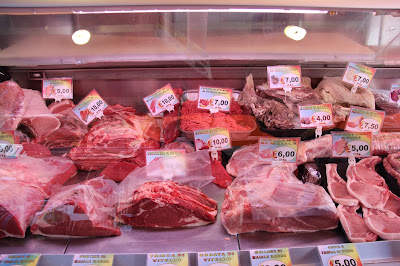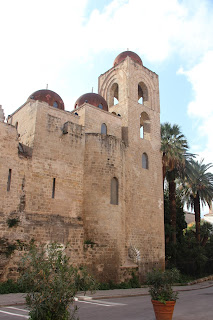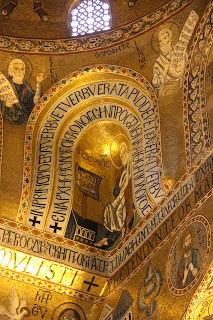We love food markets, so our goal today was to visit more of the cluster of brilliant UNESCO sites scattered around Palermo historical centre -- via yet another food market. Our plan being that we should spend the morning in the market, and very likely have lunch there, then the afternoon at the cultural sites.
For once the day went as planned, and the weather behaved: just a quick shower before we even left home, then clear for the rest of the day. So, that made for lovely walking, too, which was what I specifically wanted, as the market was taking us into the back lanes of some ancient and ruined suburbs.
We are really giving the area right and left of Quatro Canti a workout: as a large number of historical sites are tucked away in there.
In preparation for this trip I had drawn up a Google Maps of sites we might try and see during our time here. The area of destinations I anticipated visiting looked immense and I had expected we would need to quickly familiarise ourselves with local bus routes, too, so did a bit of planning for that. But, the little city centre van, Navette Centro Storico, which always goes in a single direction around the perimeter of the ancient centre, is never far away when we are tired, and need to get home, so that is all we have needed. And, apart from the threat of gangs of pick-pocketers occasionally on it, it is very useful as it comes every 10 or 11 minutes to the AMAT bus stops where there is always a board showing its route and the current stop with a red dot, so it is even better than the scheduled local buses which might do the same thing. And, that, we used again today, coming home. We even found a seat in it at the Piazza Independenza stop when we got on, so that was lucky as we had to go six stops from there.
We started our day with coffee, of course. We are becoming such regulars to a particular little hole in the wall cafe along via Maqueda, that they see us coming now, and gesture us into our favourite seats. Their morning pastries are amazingly fresh and their espresso, always good in much of Europe, is delicious.
We head, then, into the tumble of lanes that make up the famous Ballarò market, one of the two favourite markets with the locals these days. The other is Mercato del Capo, which we also hope to find time to visit before we leave. There are long, twisting lanes of stalls, many covered with red tarpaulins as protection from the weather filled with all kinds of produce and product: familiar and not. The tarps also hide the relics and wrecks of the surrounding buildings tucked away in this dismal suburb that, supposedly, are still like this from war bombing. At least that's the official story.
Meat is cheap and fresh. Yet we saw much of it entering these little lane spaces by shopping trolley: entire carcasses of Agnello (lamb) ready for the slicing. Whole heads of Agnello are on display, too, And tucked way behind the pigs' trotters, at the back, are some castrato, I notice. That, too, I will forego.
As in days of yore, the markets, which have been running for nine hundred years and more in Palermo, occasionally have a Saracen feel. Arab men in traditional garb can be still seen adding up their coin. Though, historically, they likely used an abacus.
The broccoli are lined up ready to be chopped into soups: light green and large, today: and only 99c a piece. The market stall tends to distract they eye from the dire background images behind the stalls: dilapidation, graffiti, crumbling edifices.
Freshly cut artichokes, still on their stem, arrive by Ape from the field. All around the market men are hacking away at the long stems with sharp, lethal knives in one quick downward stroke: the waste landing in the alleyway, ready for disposal after the market closes. So round and fat, many of them. I love them with hollandaise. Others are already prepared: boiled, stuffed and sold ready for re-heating. Beautifully shaped pumpkin: slashed with just a sharp knife slice and displayed like a piece of contemporary art.
Strawberries, fat and red and juicy are everywhere. This marketeer entices you with a free tasting of a whole huge berry, with a flourish of whipped cream dolloped on top. He then rolls a tray of them into a paper cone -- just for you -- but throws in a 'free' tray of almond flavoured cookies, probably left over from last market day. He then charges twice the market value, after you have been so charmed. Wise, old, rip-off agents, well versed in fleecing tourists. Ah, well: it all tastes amazing.
Swordfish are for sale, with the girth of a schoolboy. Sardines glisten. Whitebait with their black and white dotted eyes, stare mournfully straight up at you, making it too hard to even consider a purchase. Fresh fish are alive, still flapping across the chipped ice on the market table. Many are posed and trussed with string. Some decorated with a prawn for garnish. The truss likely stops them flapping off the market table to freedom, too. And there are fresh mushrooms all in a row.
Ricotta from Corleone, a little over an hour inland, is on display. I love the focus on regionality that they clarify in the markets. Ricotta is made into cakes and baked, ready prepared. Sometimes stuffed with different herbs, too. Rich sticky dates are strung together so delectably.
And we ate thick and delicious Caponata, again, for lunch: this time with chunks of tuna. I wish I could make it look and taste like this. And the Caponata was just the appetiser. We, then, had to survive primo and secondo courses as well, having ordered the set menu. My choices were smoked salmon and caper farfelle, followed by fritto misto of baby squid.
We walked away weak and could not eat, then, what we had planned for dinner.
We moved on, trying to walk it all off, through the bleak, dingy and terribly grim suburb of Albergheria: so dismal and derelict Pete would not even take photographs. Animal faeces littered the sidewalks, and giant skips overflowed with rubbish left too long for collection. Locals have taken to throwing their leftover takeout meal containers merely in the direction of the bin: rubbish everywhere. Filthy.
Living in this must be utterly depressing for the community. I cannot make sense of why the city fathers don't do something.
There are so many folk living homeless in alcoves on the streets, even the mainly pedestrian and shopping street we live on, via Maqueda. Several homeless men inhabit niches against buildings along it. One, whose dog Miss Bec pats each time she walks past, now waves to us whenever we come by. They seem to have no hope, no expectation, no life. Their day is spent sitting, staring.
Then there is the multitude of young African men here. Jobless. Prowling. Desperate. Pilfering.
And the beggars: everywhere. Young women especially, sadly teaching their young children to hold out their hands for alms. And, of course, there are old men and women begging, too. It must be lucrative.
So many aimless, purposeless people. In a city that needs so much cleaning up.
I cannot believe that the City Fathers cannot come up with a sensible program of works that would make these folk feel useful, human again. But also give them some skills. Even offering them free tools, training, soap, water, paint and stucco in return for food, basic shelter and a small stipend that could go into a bank account as pay for a contract of work, and have them start at one end of the city and begin cleaning it up: washing away centuries of grime, or re-facing unfinished ugly buildings, would be a start. At the end of that time, surely many would have life skills in the building trade that would hold them in good stead for the future. Or put them to work repairing broken roads, derelict curbing, the bridges, the railways, the ports--in return for a period of paid labour that might give them some hope, and a new beginning.
This waste of young life cannot continue. Someone needs to take charge.
So, we visit a church in the middle of it: St John of the Hermits. Another surreal experience: finding priceless historic treasures tucked away between the devil and a hard place. It is really discombobulating, as my mother used to say.
Another church, Saint Giovanni degli Eremeti, was once a mosque as its domes reveal, and a religious site has existed on some of these foundations since the 6th century, so it is ancient. Its interior is spare and square, softened by the curve of the domes. Its cloisters, with lovely capitals and arches, has an Arab cistern in the centre, and is surrounded by orange trees and a sweet smelling garden.
It still feels quite Arabic: though it is hard to appreciate it, as I am still so careworn and saddened about the tragic suburb conditions around it.
We have, then, simply to cross the road to enter the Palazzo dei Normanii, the pièce de résistance of all Palermo's sites: once the Royal Palace, now an Observatory in part, and in others used as military administrative offices.
This, too, was begun by the Arabs when they ruled Palermo from the 9th century onwards, but their Emir preferred a seaside location, and given today's experiences I am not surprised. The Norman kings who followed used the palace as their residence while they were in power and built themselves a chapel over the earlier chapel, which is now the crypt.
The State Apartments weren't open today, but we did see the UNESCO listed Capella Palatina, which is an earlier version of the exquisite Monreale Cathedral that we visited in the rain the other day. Many of the images in the mosaics are similar to the Monreale images, as the graphics and design seem of similar inspiration and origin. This chapel was commissioned by Roger 11: his grandson commissioned Monreale: mayhap he was trying a bit of one-up-manship with his grandad. And, perhaps the Constantinople craftsmen might have come from the same stone working families, too. Certainly they had similar influences.
Regardless, both are beautiful. And you can spend hours just enjoying. Well, you could, if they would provide some sort of seating for a viewer to look on high, which they don't, as usually they want you in and out as quickly as possible so the line of tourist keeps moving on through. Today, though, we had time to enjoy it, with few tourists even around at this time of the year.
 |
| Wandering the back streets in Palermo |
 |
| Wash day |
 |
| Street gallery |
 |
| Effective way to dry clothes |
 |
| Ballarò market |
 |
| Great slabs of meat |
 |
| Entire carcasses ready for the carving |
 |
| Pigs' trotters and castrato |
 |
| Arab type traders in traditional garb count their coins |
 |
| Cheap fresh brassica |
 |
| Fresh artichokes arrive by Ape |
 |
| Just cut artichokes |
 |
| Prepared food ready for sale |
 |
| Simple interesting display |
 |
| Free strawberries are not always free |
 |
| Huge swordfish |
 |
| Glistening sardines |
 |
| Whitebait by the ton |
 |
| Trussed fish with prawn garnish |
 |
| All in a row |
 |
| Corleone ricotta |
 |
| Ricotta stuffed with herbs |
 |
| Sticky dates strung together |
 |
| Fritto misto of baby squid |
 |
| Saint Giovanni degli Eremeti, was once a mosque |
 |
| The inner dome |
 |
| Cloister and scented garden |
 |
| Palazzo dei Normanii, the pièce de résistance |
 |
| Capella Palatina |
 |
| Cloisters and layers of arched walkways |
No comments:
Post a Comment